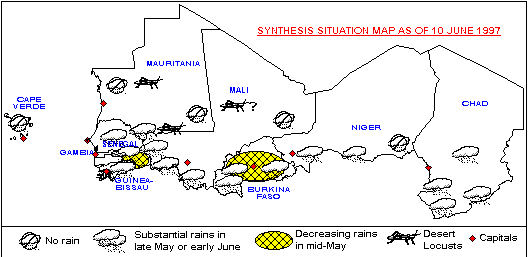


Land preparation and planting are progressing following the onset of the rains. Dry planting is also underway, notably in Senegal. Seasonably dry conditions prevail in Cape Verde and northern parts of Mali, Niger and Chad.
Grasshoppers are reported in Ouaddaï region of Chad. Moderate numbers of solitary Desert Locust adults and perhaps a few small groups will move west across the Red Sea to the interior of Sudan and perhaps continue towards West Africa over Chad and Niger if they find dry conditions en route. Small-scale egg laying could occur with the onset of the rains.
Sahelian zone: Where average annual precipitation ranges between 250 and 500 mm. This zone is at the limit of perennial vegetation. In parts where precipitation is less than 350 mm, only pastures and occasional short-cycle drought-resistant cereal crops are grown; all cropping in this zone is subject to high risk.
Sudano-Sahelian zone: Where average annual precipitation ranges from 500 to 900 mm. In those parts of this zone where precipitation is less than 700 mm, mostly crops with a short growing cycle of 90 days are generally cultivated predominantly sorghum and millet.
Sudanian zone: Where average annual precipitation ranges from 900 to 1 100 mm. In this zone, most cereal crops have a growing cycle of 120 days or more. Most cereals, notably maize, root and cash crops are grown in this zone.
Guinean zone: Where average annual precipitation exceeds 1 100 mm. Guinea-Bissau and a small area of southern Burkina Faso belong to this zone, more suited to root crop cultivation.
Reference will also be made to the Intertropical Convergence Zone (ITCZ), also known by its trace on the earth's surface, called the Intertropical Front. The ITCZ is a quasi-permanent zone between two air masses separating the northern and southern hemisphere trade winds. The ITCZ moves north and south of the equator and usually reaches its most northerly position in July. Its position defines the northern limits of possible precipitation in the Sahel; rain-bearing clouds are generally situated 150-200 km south of the Intertropical Front.